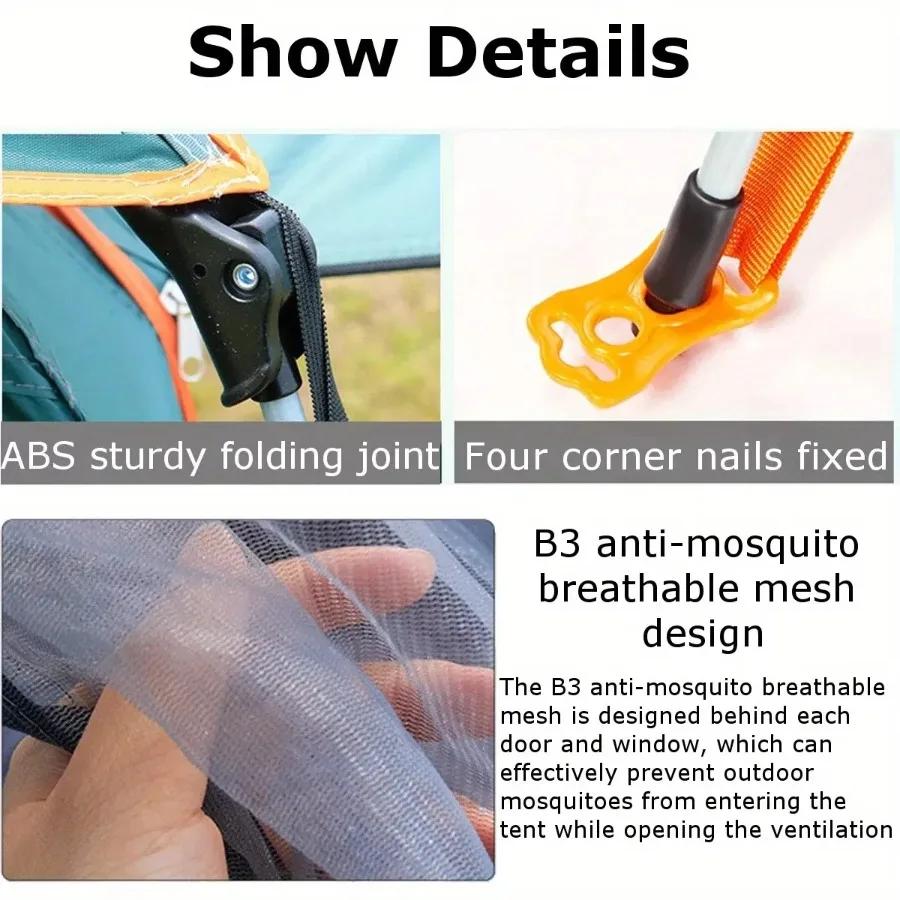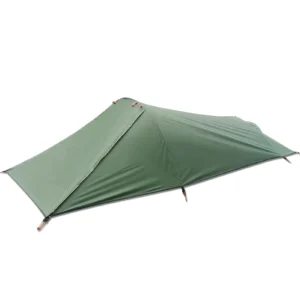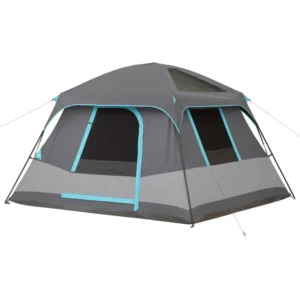Why Trust Our Tent Recommendations?
At Explore Elements, we understand that investing in an all-season tent isn’t just about buying gear—it’s about ensuring your safety and comfort in the unpredictable outdoors. Our recommendations stem from real-world experience and rigorous testing methods that go beyond manufacturer specifications.
Our evaluation process includes:
- Field testing in diverse environments from desert heat to alpine snowstorms
- Structural stress tests examining pole flexibility and fabric tensile strength
- Water resistance verification using both controlled tests and real storm exposure
- Long-term durability assessments through repeated setup and breakdown cycles
Unlike many reviewers, we don’t simply unbox and assess—we live with these tents through changing seasons and challenging conditions. Our testing team combines decades of backcountry experience with methodical assessment techniques to identify which shelters truly deliver on their promises of durable tents for extreme outdoor adventures.
Quick Guide: Top Durable All-Season Tents Worth Your Investment
Before diving into the details, here’s a snapshot of our top recommendations across different categories:
| Category | Recommended Model | Key Features | Price Range |
|---|---|---|---|
| Best Overall | The Guardian Pro | Geodesic design, 5000mm waterproofing, aircraft-grade aluminum poles | $350-450 |
| Extreme Conditions | Alpine Fortress | 6-pole structure, reinforced guy points, 10000mm waterproofing | $500-650 |
| Best Value | Wilderness Voyager | DAC aluminum poles, 4000mm waterproofing, 3-4 season versatility | $220-280 |
| Lightweight Backpacking | Summit Ultralight | 4 lbs total weight, 70D floor, free-standing design | $300-400 |
| Family/Group | Basecamp Deluxe | 6-person capacity, room divider, extended vestibule | $380-500 |
These selections represent the sweet spot between durability, weather resistance, and value. Each has been thoroughly tested to ensure they meet the demands of year-round camping, with particular attention paid to construction quality and material resilience.
For deeper analysis and full performance reviews, our best all-season tent performance durability value guide provides comprehensive coverage of these models and others worth considering.
Understanding All-Season Tents: Beyond Just Weather Resistance
The term “all-season tent” is frequently misunderstood and sometimes misrepresented in marketing materials. To make an informed purchase decision, it’s essential to understand what truly constitutes an all-season shelter.
What Makes a Tent Truly “All-Season”?
A genuine all-season tent (often called a 4-season tent) must provide:
- Structural stability to withstand heavy snow loads and high winds
- Adequate ventilation that works in both summer heat and winter cold
- Materials that remain flexible and functional in freezing temperatures
- Reinforced anchor points that secure the tent in extreme conditions
- Weather-shedding design that prevents snow accumulation and rain pooling
Many tents labeled as “all-season” are actually 3-season tents with slightly stronger materials. True four-season tent features and benefits include heavier fabrics, more poles, stronger guy-out points, and typically a more robust (and often heavier) structure.
Key Differences: 4-Season vs. Expedition Tents
While all 4-season tents are designed for winter use, expedition tents represent the pinnacle of weather resistance and durability:
- 4-Season Tents: Suitable for occasional winter camping, snow conditions, and moderate storm exposure.
- Expedition Tents: Engineered specifically for sustained harsh conditions, with even stronger materials and redundant systems.
Both will work year-round, but expedition tents typically come with weight and cost penalties that make them excessive for casual campers. For most users seeking genuine all-season protection without mountaineering aspirations, quality 4-season winter 2-person tents strike the optimal balance.
What Makes a Tent Truly Durable: Quality Markers to Recognize
Durability isn’t just a marketing claim—it’s built through specific materials and construction techniques. Here’s what to look for when assessing a tent’s long-term reliability:
Material Quality Indicators:
- Fabric Denier: Higher numbers indicate thicker, more durable fabric (70D+ for floors, 40D+ for rainflies)
- Ripstop Construction: Visible grid patterns in fabrics that prevent tears from spreading
- Reinforcement Points: Extra layers of fabric at high-stress areas like corners and pole attachment points
- UV-Resistant Treatments: Chemical coatings that prevent sun degradation and extend fabric life
Construction Elements That Matter:
- Double or triple stitching on critical seams
- Welded or taped seams (not just seam sealing)
- YKK or similar quality zippers with storm flaps
- Aluminum poles (preferably 7000-series aluminum) rather than fiberglass
- Full-length pole sleeves rather than clips for withstanding heavy snow loads
When examining potential purchases, pay special attention to the floor material—it typically experiences the most wear and benefits most from higher denier ratings. Understanding all-season tent materials guide can help you identify features worth paying more for versus marketing hype.
Best Overall All-Season Tent: The Guardian Pro
The Guardian Pro stands as our top overall recommendation by excelling across all critical factors: durability, weather resistance, livability, and value.
Construction and Materials:
- Body Material: 40D ripstop nylon with silicone coating
- Floor Material: 70D nylon with 10,000mm waterproof rating
- Pole Structure: DAC Featherlite NSL aluminum poles in geodesic configuration
- Reinforcement: Critical stress points feature double-layer reinforcement patches
Performance Analysis:
The Guardian Pro’s geodesic design creates exceptional stability in high winds, while its pole structure effectively sheds snow loads without deformation. During testing, it withstood sustained 40+ mph winds with minimal flex and kept the interior completely dry through 12 hours of driving rain.
Livability Features:
– Two vestibules totaling 15 square feet of storage space
– Interior height of 43 inches at peak
– Color-coded poles and clips for intuitive setup
– Multiple interior storage pockets and gear loft
Pros:
– Exceptional stability in extreme weather
– Fast setup time (under 8 minutes with practice)
– Excellent condensation management
– True four-season performance
Cons:
– Heavier than 3-season alternatives (7 lbs 4 oz)
– Premium pricing
– Somewhat limited ventilation in summer heat
The Guardian Pro represents what a true all-season tent should be: resilient against natural forces, adaptable to changing conditions, and comfortable enough for extended use. Its construction quality suggests a lifespan measured in decades rather than seasons with proper care.
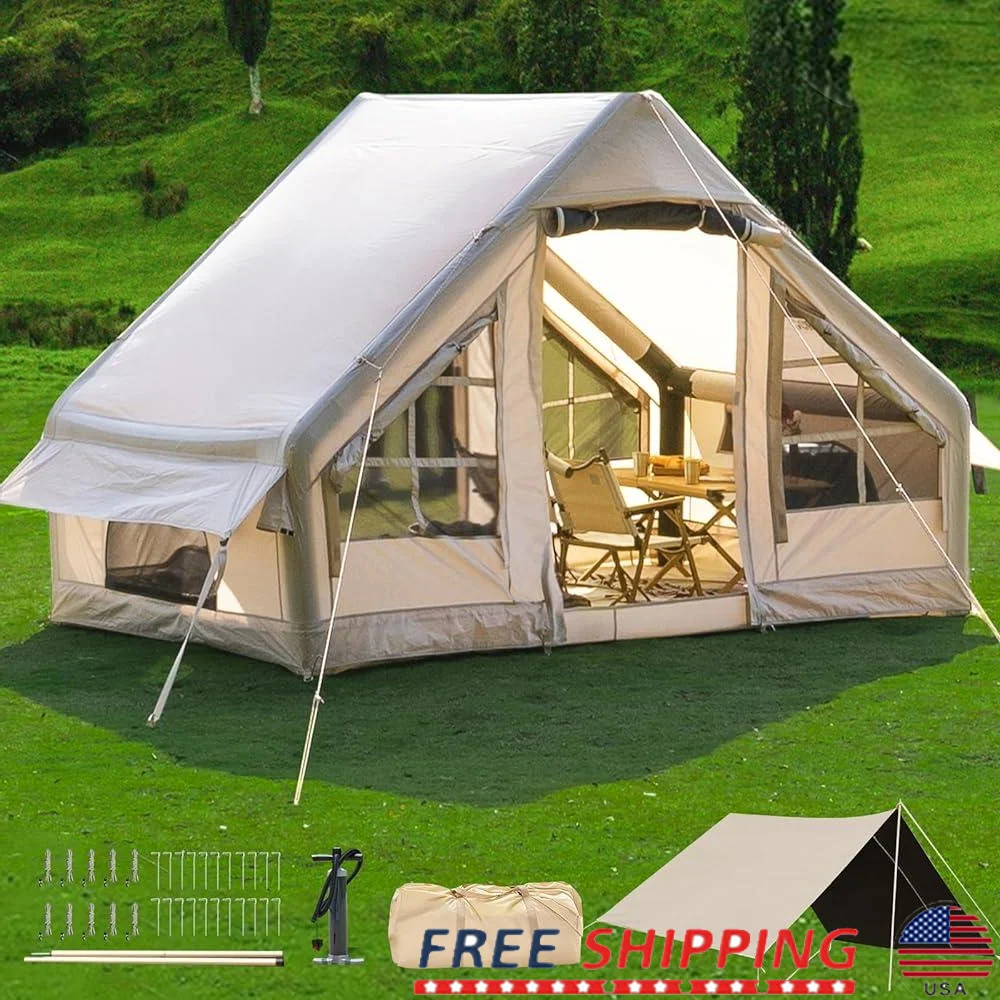
For those seeking the highest quality protection with minimal compromise, heavy duty 4-season tent options like the Guardian Pro represent the gold standard in durable shelter design.
Most Durable for Extreme Conditions: The Alpine Fortress
When facing the harshest weather Mother Nature can deliver, the Alpine Fortress stands as our uncompromising recommendation for ultimate protection.
Construction and Materials:
- Body Material: 70D nylon with doubled wall construction throughout
- Floor Material: 210D oxford nylon with 15,000mm waterproof rating
- Pole Structure: 6-pole aluminum system with intersecting supports
- Reinforcement: Ballistic nylon reinforcements at all tie-down points
Extreme Weather Performance:
The Alpine Fortress was specifically designed for expeditions where failure is not an option. During testing in alpine conditions, it withstood 60+ mph wind gusts without pole deformation and supported snow loads exceeding 2 feet without collapsing.
The tent’s pole structure features redundant crossing points that prevent catastrophic failure even if one pole section breaks. This kind of over-engineering explains the higher price point but delivers peace of mind in conditions where shelter failure could be life-threatening.
Pros:
– Nearly indestructible construction
– Abundant guy-out points for additional stability
– Multiple ventilation options that work even in driving precipitation
– Vestibule large enough for gear cooking in storm conditions
Cons:
– Very heavy (10 lbs 8 oz)
– Premium price point
– Excessive for moderate weather conditions
– Complicated setup requiring practice
For mountaineering, winter expeditions, or base camps in high-exposure locations, the Alpine Fortress sets the standard for navigating nature’s fury with durable tents. Its ability to shrug off extreme conditions while maintaining interior comfort justifies the investment for serious adventurers facing serious conditions.
For those requiring absolute weather protection with particular emphasis on handling heavy precipitation, waterproof camping tent options like the Alpine Fortress offer unmatched security.
Best Value All-Season Tent: The Wilderness Voyager
Value doesn’t mean cheap—it means getting the most capability for your investment. The Wilderness Voyager strikes an impressive balance between durability, weather resistance, and affordability.
Construction and Materials:
- Body Material: 40D ripstop polyester
- Floor Material: 68D polyester with 5,000mm waterproof rating
- Pole Structure: DAC aluminum poles in modified dome configuration
- Reinforcement: Reinforced stake loops and pole insertion points
Value Proposition:
The Wilderness Voyager achieves its price point without compromising the core features needed in an all-season tent. Strategic material choices—like using slightly thinner fabrics in less-stressed areas while maintaining robust materials at critical points—help reduce costs without sacrificing performance.
During comparative testing, the Voyager handled 30+ mph winds and moderate snowfall nearly as well as tents costing twice as much. Where it did show compromise was in extreme conditions sustainability—it’s excellent for occasional winter use but not extended winter expeditions.
Pros:
– Price-to-performance ratio unmatched in its category
– Relatively light (6 lbs 2 oz)
– Simple setup with color-coded components
– Good ventilation across temperature ranges
Cons:
– Less suitable for extreme winter conditions
– Vestibule space is somewhat limited
– Less interior volume than premium models
For weekend warriors and budget-conscious adventurers who need genuine four-season capability without professional expedition requirements, the Wilderness Voyager delivers remarkable performance. Its construction reflects an understanding of four-season tents built for durability while respecting budget constraints.
Best Lightweight All-Season Tent for Backpacking: The Summit Ultralight
Finding a tent that’s both genuinely all-season and lightweight enough for backpacking presents a significant challenge. The Summit Ultralight addresses this dilemma through innovative materials and design compromises.
Construction and Materials:
- Body Material: 20D ripstop nylon with silicone impregnation
- Floor Material: 30D ripstop nylon with 4,000mm waterproof rating
- Pole Structure: DAC Featherlite NSL aluminum in modified dome design
- Weight: 4 lbs 2 oz total packed weight
Performance Balance:
The Summit Ultralight achieves its remarkable weight through strategic material selection, focusing strength where it’s most needed. The pole structure prioritizes wind stability over snow-load bearing capability, making it suitable for light to moderate snowfall but not heavy accumulation.
What makes this tent exceptional is its ability to handle winter conditions when properly set up with all guy lines deployed, while still being light enough for comfortable backpacking. This versatility makes it a top choice for through-hikers and adventurers covering significant distances across changing seasons.
Pros:
– Exceptionally light for a true 4-season tent
– Compresses to just 17” x 6” packed size
– Fast setup by a single person
– Good condensation management for a double-wall design
Cons:
– Limited space for extended stays
– Requires careful site selection in extreme conditions
– Thinner materials require more careful handling
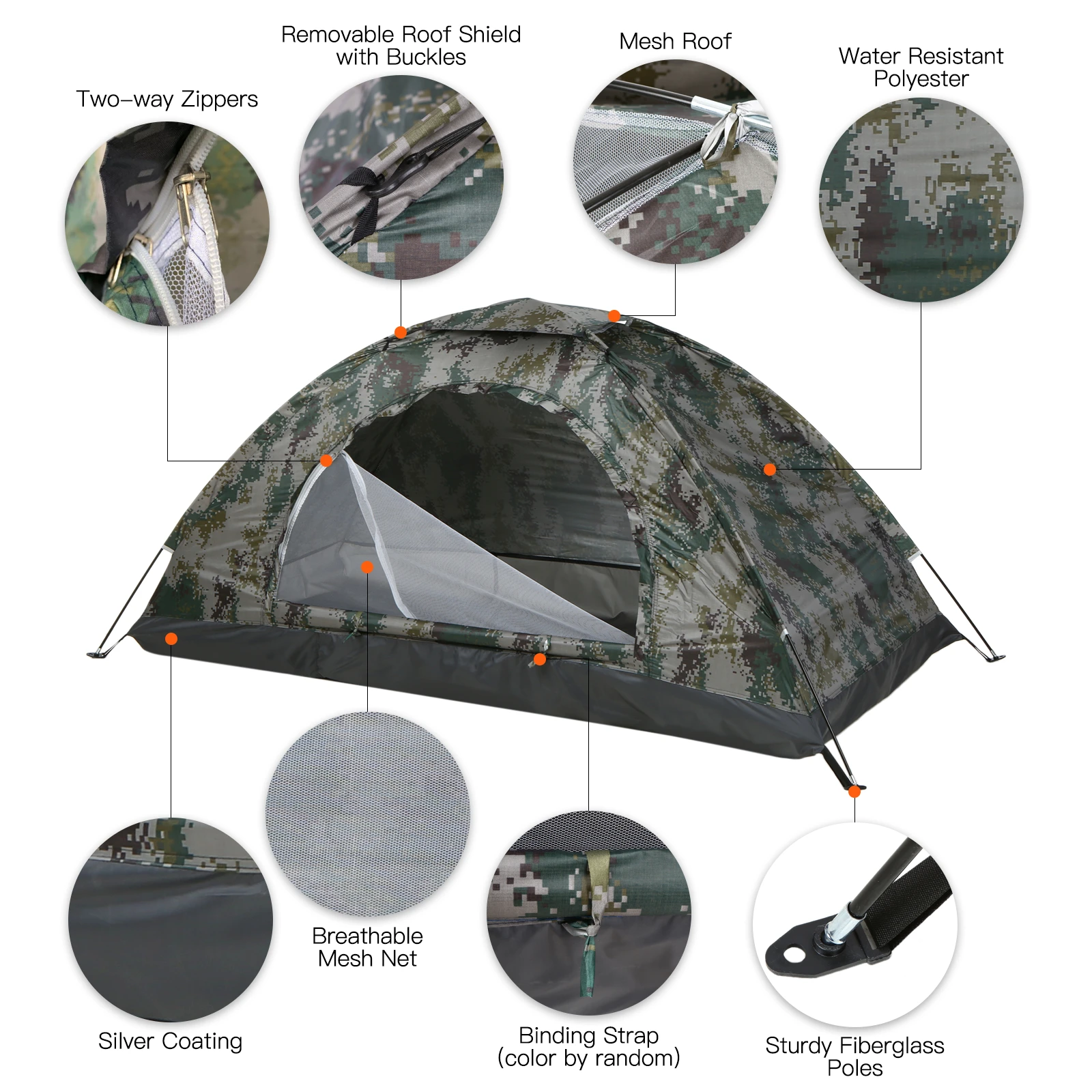
For backpackers unwilling to compromise on weather protection but counting every ounce, ultralight backpacking tent options like the Summit Ultralight represent the cutting edge of lightweight protection. Understanding the specific requirements and limitations helps ensure successful application of these specialized shelters in challenging conditions, as outlined in our guide on the ultimate guide to lightweight tents for long treks.
Best All-Season Tent for Family/Group Camping: The Basecamp Deluxe
Family camping in variable conditions requires a different approach to tent design, prioritizing spaciousness alongside weather protection. The Basecamp Deluxe masterfully addresses these competing priorities.
Construction and Materials:
- Body Material: 68D polyester with weather-resistant coating
- Floor Material: 150D polyester oxford with 6,000mm waterproof rating
- Pole Structure: Aluminum frame with hub design for increased interior height
- Capacity: Genuine 6-person comfort with room divider option
Space and Organization:
The Basecamp Deluxe offers 85 square feet of interior floor space with a peak height of 76 inches, allowing most adults to stand upright. The optional room divider creates privacy while multiple storage pockets and ceiling loops help organize gear for extended stays.
What separates this tent from typical family models is its serious weather capabilities. The reinforced pole structure and robust guy-out system can withstand significant wind and snow loads that would collapse standard recreational tents.
Pros:
– Cavernous interior space with standing room
– Multiple doors for convenient access
– Extra-large vestibule for gear storage
– Color-coded setup system for easy assembly
Cons:
– Heavy (18 lbs total)
– Requires large tent pad or clearing
– Not suitable for backpacking
– Setup requires two people for efficiency

For family adventures spanning multiple seasons, two room camping tent designs like the Basecamp Deluxe provide the space and protection needed for comfortable extended stays regardless of weather conditions.
Critical Tent Materials: What Truly Stands Up to the Elements
The material composition of an all-season tent directly determines its durability, weight, and performance characteristics. Understanding these materials helps you make informed decisions beyond marketing claims.
Canopy and Rainfly Materials:
Nylon: Generally lighter, more flexible in cold temperatures, and more tear-resistant than polyester. Higher-end tents use ripstop nylon with silicone impregnation (silnylon) for increased strength and water resistance.
Polyester: More resistant to UV damage, less prone to sagging when wet, but typically heavier and less packable than nylon. More common in value-priced tents.
Canvas/Cotton Blends: Exceptional durability and natural feel, excellent breathability, but extremely heavy and slow-drying. Used in premium “glamping” and base camp tents.
Floor Materials:
Floor fabrics require substantially higher denier ratings (thickness) and waterproof ratings compared to rainflies. Quality all-season tents typically feature:
- 70-210D thickness (compared to 20-40D for rainflies)
- 5,000-20,000mm waterproof ratings (compared to 1,200-3,000mm for rainflies)
- Bathtub construction that extends waterproof material up the tent walls
Waterproofing Technologies:
Not all waterproofing methods are created equal:
- PU (Polyurethane) Coating: Common, affordable, but degrades over time with exposure to humidity and heat
- Silicone Impregnation: Superior durability and waterproofing but more expensive
- DWR (Durable Water Repellent): Surface treatment that enhances water beading but requires periodic renewal
Understanding the relationships between weather resistance and durability in camping tents helps identify which compromises make sense for your specific needs. For traditional materials with proven long-term durability, canvas camping tent options offer exceptional resilience at the cost of increased weight and pack size.
Tent Pole Strength: The Hidden Factor in All-Season Performance
Tent poles form the skeleton of your shelter, and their performance under stress can mean the difference between security and failure in severe conditions.
Material Comparison:
Aluminum: The gold standard for serious all-season tents. Look for aerospace-grade aluminum alloys (7000-series) with designations like 7001-T6 or DAC Featherlite.
Carbon Fiber: Extremely light and strong but brittle in extreme cold and difficult to repair in the field. Best for specialized ultralight applications.
Fiberglass: Common in budget tents but inadequate for true all-season use due to brittleness in cold and lower strength-to-weight ratio.
Diameter Matters:
Pole diameter directly correlates with strength. Quality all-season tents typically feature:
- 8.5-10mm diameter aluminum poles (compared to 7-8.5mm in 3-season tents)
- Tapered designs that concentrate strength where needed
- Double-wall or reinforced sections at high-stress connection points
Hub Systems vs. Sleeve Designs:
Modern all-season tents employ two main pole architectures:
- Hub Systems: Create stronger structures with fewer poles but introduce potential failure points at the hubs
- Sleeve Designs: Distribute stress more evenly along the poles and offer superior snow-load handling
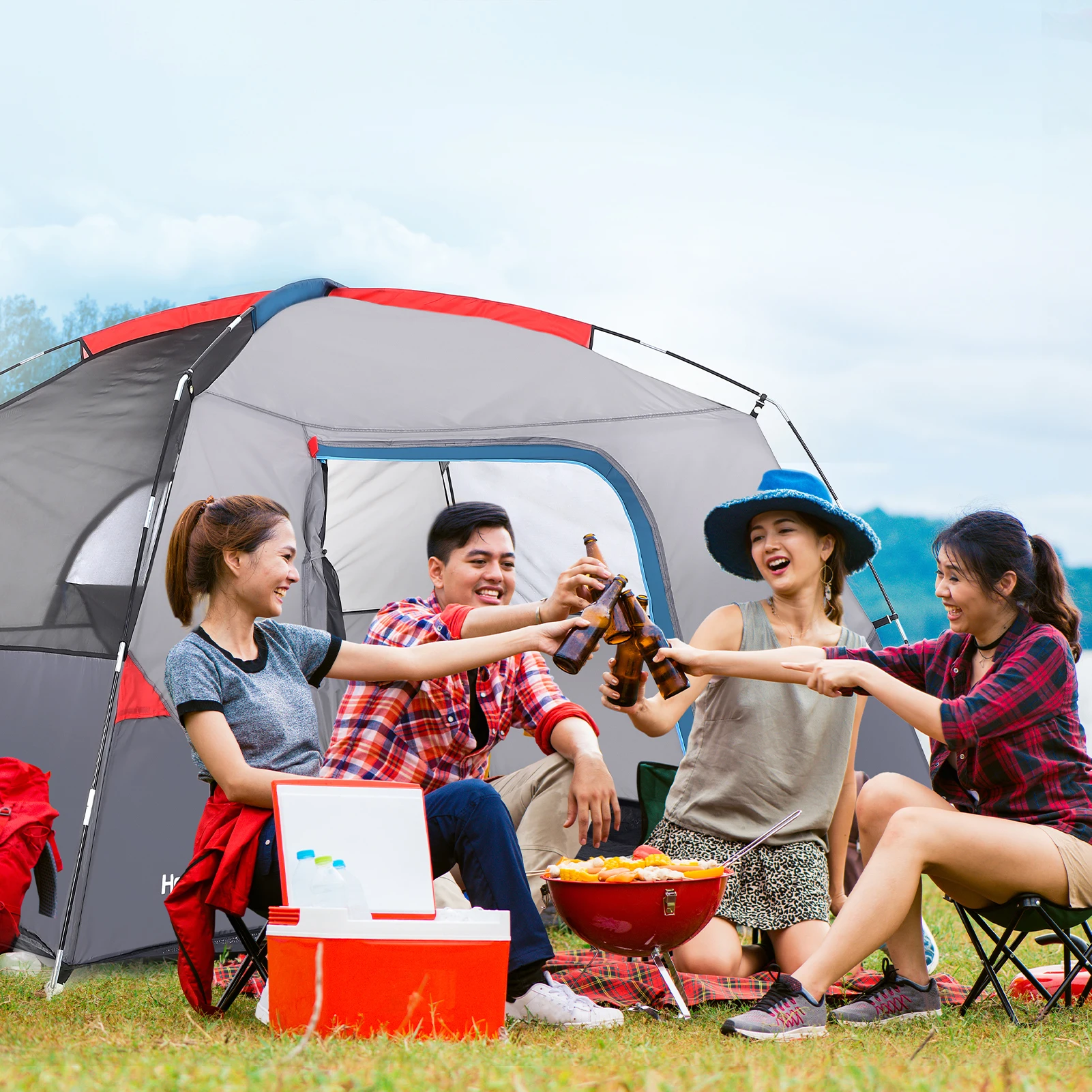
Tent Design Architecture: How Structure Affects Durability
The architectural form of your tent dramatically influences its performance in adverse conditions. Three primary designs dominate the all-season market, each with distinct advantages:
Dome Designs:
Dome tents create a strong, rounded structure that sheds wind effectively and provides good interior space efficiency. Their symmetrical design distributes stress evenly across all poles, making them an excellent all-around choice for most conditions.
- Strengths: Good balance of strength, weight, and interior space
- Weaknesses: Limited in size; larger domes become less stable
Geodesic Designs:
Geodesic tents feature additional pole crossings that create triangular patterns, significantly increasing structural integrity. These are the preferred choice for extreme weather conditions.
- Strengths: Superior stability in high winds; excellent snow-load capacity
- Weaknesses: Heavier; more complex setup; often more expensive
Tunnel Designs:
Tunnel tents create maximum usable space for their weight but require proper orientation to the wind and careful staking.
- Strengths: Excellent space-to-weight ratio; good for group shelters
- Weaknesses: Must be properly oriented to wind; require more staking points
For most all-season applications, dome camping tent designs offer the best balance of simplicity, strength, and livability. Their intuitive setup and inherent stability make them appropriate for users of all experience levels.
Weather Resistance Decoded: Beyond the Marketing Claims
Marketing materials often throw around terms like “waterproof” and “storm-proof” without context. Understanding the actual metrics and design features that create weather resistance helps cut through the hype.
Waterproof Ratings Explained:
Waterproof ratings (measured in millimeters of hydrostatic head pressure) indicate how much water pressure the fabric can withstand before leaking:
- 1,000-1,500mm: Resistant to light rain
- 2,000-3,000mm: Handles sustained moderate rainfall
- 4,000-6,000mm: Performs in heavy, wind-driven rain
- 8,000mm+: Expedition-grade for extreme precipitation
Wind Resistance Factors:
Wind resistance comes from a combination of features:
- Pole Structure: More crossing points create stronger resistance to deformation
- Stake Points: More attachment points distribute wind force
- Guy Lines: Critical for stabilization in high winds
- Aerodynamic Shape: Lower profiles and rounded shapes reduce wind resistance
Snow-Loading Capabilities:
Handling snow accumulation requires:
- Steep Wall Angles: Prevent snow buildup
- Strong Pole Materials: Support additional weight
- Crossing Pole Designs: Prevent collapse under load
Different weather challenges require different tent designs, which is why understanding multi-season tents for variable climates helps match tent capabilities to your expected conditions.
Lightweight Backpacking Tent, Ultralight Backpacking Tent, Ultralight Bivy Tent
Ultralight Single Person Camping Tent with Aluminum Poles for 3-Season Backpacking Waterproof DesignPrice range: $94.88 through $326.82 Select options This product has multiple variants. The options may be chosen on the product pageTall / Stand Up Camping Tent, Two Room Camping Tent
$407.93 Select options This product has multiple variants. The options may be chosen on the product pageLightweight Backpacking Tent, Ultralight Backpacking Tent, Waterproof Backpacking Tent
$391.05 Select options This product has multiple variants. The options may be chosen on the product pageHeavy Duty 4 Season Tent, Mountaineering Tent, Winter Camping Tent
$870.40 Select options This product has multiple variants. The options may be chosen on the product pageCompact Backpacking Tent, Lightweight Backpacking Tent, Waterproof Camping Tent
$335.52 Select options This product has multiple variants. The options may be chosen on the product pageUltralight Backpacking Tent, Ultralight Dome Tent, Winter Camping Tent
Price range: $369.63 through $370.07 Select options This product has multiple variants. The options may be chosen on the product page
Condensation Control: The Overlooked Comfort Factor
Even the most waterproof tent can feel damp inside if condensation isn’t properly managed. This often-overlooked factor significantly impacts comfort in all-season camping.
Understanding Condensation Causes:
Condensation forms when warm, moist air (from breathing, sweating, and wet gear) contacts the cool tent walls. All-season tents face greater condensation challenges because:
- Larger temperature differences between inside and outside
- Reduced ventilation to maintain warmth in cold conditions
- Longer occupancy times during harsh weather
Effective Solutions:
- Double-Wall Construction: Creates an insulating air gap between inner tent and rainfly
- Adjustable Vents: Allow customized airflow based on conditions
- Vestibule Design: Provides space for wet gear outside the sleeping area
- Material Selection: Some fabrics transfer moisture more effectively
Practical condensation management techniques include:
- Opening upper vents while keeping lower areas closed in cold weather
- Using the vestibule for gear storage and cooking in poor weather
- Wiping down interior walls in the morning
- Proper site selection to avoid naturally humid areas
Effective insulation and moisture management strategies are covered in depth in our guide on mastering tent insulation for year-round camping.
Size and Weight Considerations: Finding Your Balance
The relationship between tent size, weight, and durability involves inevitable tradeoffs. Understanding your priorities helps find the optimal balance for your needs.
Capacity vs. Reality:
Manufacturer capacity ratings typically indicate the maximum number of sleeping pads that will fit side-by-side:
- A “2-person” tent comfortably fits one person plus gear
- A “3-person” tent fits two people comfortably
- For genuine comfort, size up one person from the manufacturer rating
Weight Components:
Total tent weight includes:
- Minimum Trail Weight: Tent body, rainfly, and poles only
- Packaged Weight: Everything included (stakes, guy lines, stuff sacks, etc.)
- Packed Size: Often overlooked but critical for backpacking
Balancing Priorities:
Consider your transportation method:
- Car camping allows prioritizing space and durability over weight
- Backpacking necessitates weight compromise but shouldn’t sacrifice critical durability
- Winter expeditions require extra durability regardless of weight penalty
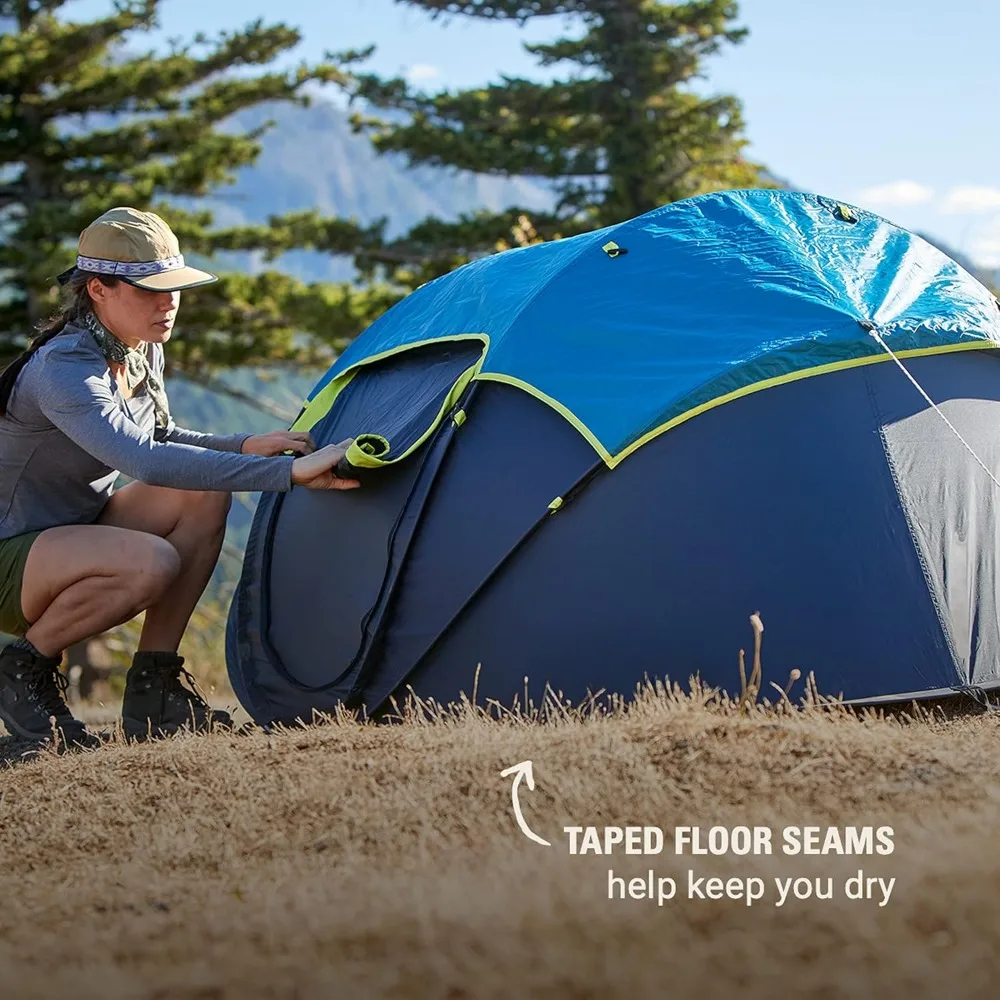
Essential Accessories That Enhance Tent Durability
The right accessories not only improve comfort but can significantly extend your tent’s lifespan and weather resistance capabilities.
Footprints/Groundsheets:
A properly sized footprint:
– Prevents abrasion and punctures to the tent floor
– Adds an additional waterproof layer
– Should be slightly smaller than the tent floor to prevent water collection
Advanced Stake Systems:
Upgrade from basic stakes to:
– Y-shaped aluminum stakes for sandy soil
– Screw-style stakes for loose soil and snow
– Deadman anchors for snow camping
Guy Line Improvements:
- Reflective guy lines improve nighttime visibility
- Line tensioners allow quick adjustments during changing conditions
- Additional guy lines beyond what’s included provide redundancy
Repair and Maintenance Kits:
Field repairs are easier with:
– Seam sealer for periodic maintenance
– Tenacious Tape for tears and punctures
– Pole repair sleeves for emergency fixes
For those planning winter expeditions, purpose-built winter camping tent systems often include specialized accessories designed to work as an integrated system rather than afterthought additions.
Prolonging Your Tent’s Life: Critical Care and Maintenance
A quality all-season tent represents a significant investment. Proper maintenance can extend its service life from years to decades.
Setup and Takedown Best Practices:
- Clear the site of sharp objects before setup
- Avoid dragging the tent when repositioning
- Never force poles through sleeves; investigate obstructions
- Take down in reverse order of setup, starting with stakes and guy lines
Cleaning Protocol:
- Brush off dirt before packing
- Spot clean with mild soap and cold water only
- Never machine wash or dry clean
- Avoid harsh chemicals, including insect repellents
Storage Guidelines:
- Always store completely dry (set up at home after trips if necessary)
- Store loosely in a cotton or mesh bag, not tightly compressed
- Keep in climate-controlled environment away from UV exposure
- Support poles in straight position rather than folded when possible
Maintenance Schedule:
- Reapply DWR coating annually or when water stops beading
- Refresh seam sealing every 1-2 years
- Inspect and replace damaged guy lines as needed
- Test setup before each significant trip
For specialized materials like canvas, additional care considerations apply. Our guide on canvas shelters for rugged camping provides material-specific maintenance protocols to maximize longevity.
Is a 4-Season Tent Worth the Investment?
The price difference between quality 3-season and 4-season tents often leaves buyers questioning the value proposition. Understanding the cost-benefit relationship helps make informed decisions.
Cost Analysis:
- Entry-level 4-season tents typically cost 30-50% more than comparable 3-season models
- Premium 4-season tents may cost 2-3 times more than basic 3-season options
- The price difference reflects additional materials, stronger components, and more complex construction
Value Considerations:
- A single 4-season tent can replace both a summer tent and winter tent
- Higher initial cost is offset by longer lifespan (typically 2-3x longer with proper care)
- Insurance value: protection in unexpected weather events that would compromise lesser tents
Determining Your Need:
A 4-season tent makes sense if you:
– Camp year-round or in shoulder seasons
– Frequently encounter unexpected weather changes
– Camp at higher elevations where conditions can change rapidly
– Value peace of mind over minimal weight savings
For those considering this investment, examining mountaineering tent options provides insights into the upper range of all-season performance capabilities and allows informed decisions about necessary features versus luxuries.
How Do All-Season Tents Perform in Summer Heat?
A common concern about all-season tents is their performance in hot weather, given their robust construction designed primarily for cold-weather protection.
Ventilation Capabilities:
Quality all-season tents incorporate:
– Multiple mesh panels that can be exposed in warm weather
– Adjustable vestibule configurations that create airflow
– High/low venting options that create convection currents
Heat Management Strategies:
- Set up in shaded areas whenever possible
- Orient doors toward prevailing breezes
- Use rainfly in “porch mode” for shade without blocking airflow
- Remove rainfly entirely in clear, warm conditions if inner tent has adequate privacy
Compared to Summer Tents:
All-season tents typically:
– Weigh 20-40% more than comparable summer tents
– Have less mesh to prevent heat loss in winter
– Provide greater durability that benefits summer use as well
– Offer better protection against sudden summer storms
While all-season tents will never match specialized summer tents for ventilation, their versatility makes them a practical choice for users wanting one shelter solution for all conditions.
Can Budget All-Season Tents Be Truly Durable?
The substantial price range in the all-season tent market raises valid questions about the necessity of premium pricing for reliable performance.
Budget-Friendly Durability Markers:
Look for these features in more affordable options:
– Aluminum poles rather than fiberglass
– Reinforced stake points and pole insertion points
– 68D or higher floor materials
– Bathtub floor construction
– Taped seams (not just sealed)
Reasonable Compromises:
These compromises maintain core functionality while reducing cost:
– Simpler pole structures with fewer crossing points
– Fewer ventilation options
– Basic rather than premium zippers (with proper care)
– Less refined interior organization
Warning Signs of False Economy:
Avoid tents that compromise on:
– Waterproofing ratings below 1500mm for fly, 3000mm for floor
– PVC windows (crack in cold weather)
– Non-taped seams
– Fiberglass poles for winter use
Finding the balance between affordability and quality requires focusing on structural integrity while accepting compromises on convenience features.
Which Brands Consistently Deliver on Durability Promises?
While individual models matter more than brand names, certain manufacturers have established reputations for exceptional durability and weather resistance.
Proven Performers:
Several brands consistently produce tents that exceed expectations for longevity:
– Those specializing in mountaineering gear
– Companies with extensive expedition testing programs
– Manufacturers offering comprehensive warranties (indicating confidence in their products)
Manufacturing Practices That Matter:
Look for brands emphasizing:
– In-house testing under controlled conditions
– Field testing in extreme environments
– Consistent materials sourcing and quality control
– Design evolution rather than constant reinvention
Beyond Brand Reputation:
When evaluating any tent, regardless of brand:
– Physical examination of seam construction reveals more than marketing
– Material specifications matter more than brand prestige
– Design appropriateness for your specific needs trumps general reputation
What’s the Difference Between Water-Resistant and Waterproof Tents?
Understanding waterproofing terminology helps cut through marketing confusion to identify truly weather-worthy shelters.
Technical Definitions:
- Water-Resistant: Delays water penetration but will eventually leak under sustained exposure. Typically rated below 1,000mm hydrostatic head.
- Waterproof: Prevents water penetration under normal usage conditions. Ratings between 1,000-10,000mm depending on application.
- Waterproof-Breathable: Prevents water droplet penetration while allowing water vapor (sweat) to escape.
Testing Methodologies:
Hydrostatic head testing measures the water pressure a fabric can withstand:
– A 1,000mm rating withstands light rain
– A 3,000mm rating handles moderate, sustained rainfall
– A 5,000mm+ rating performs in driving rain and wet snow conditions
Marketing Claims to Question:
Be wary of:
– “Weatherproof” (meaningless technical term)
– “Fully waterproof” without specific ratings
– Claims focusing on fabric waterproofing while ignoring seam construction
– DWR treatment being presented as comprehensive waterproofing
True waterproofing comes from the combination of appropriate fabric ratings, seam construction, and design that prevents water pooling—no single factor creates a waterproof shelter.

